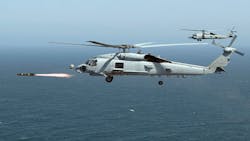Global Manufacturer: How Risky is the Defense Supply Chain?
The U.S. relies on a single Chinese company for buta-netriol (BT), the chemical needed to produce the solid rocket fuel used to propel Hellfire air-to-ground missiles. Hellfire missiles are launched from attack helicopters and unmanned drones. The last U.S. producer of BT, Cytec Industries, discontinued production in 2004.
See Also: Global Manufacturing Economy Trends & Analysis
That is but one example of what a recent report, commissioned by the Alliance for American Manufacturing, called "our military's growing and dangerous reliance on foreign nations for the raw materials, parts and finished products needed to defend the American people."
"Remaking American Security," authored by Guardian Six Consulting President John Adams, a retired Army general, warns that "foreign sourcing puts America's military readiness in the hands of potentially unreliable supplier nations and undermines the ability to develop capabilities needed to win on future battlefields." The report calls for action to increase domestic production of the natural resources and manufactured goods necessary to equip the U.S. military.
"America's vulnerability today is frightening," said Adams. "This report is a wake-up call for America to pay attention to the growing threat posed by the steady deterioration of our defense industrial base. Excessive and unwise outsourcing of American manufacturing to other nations weakens America's military capability. As a soldier, I've witnessed firsthand the importance of our nation's ability to rapidly produce and field a sophisticated array of capabilities. There is a real risk that supply chain vulnerabilities will hamper our response to future threats."
The debate over how much of the United States' weaponry and other defense materials should be made domestically pits worries about U.S. security and the nation's ability to arm itself against ongoing (and increasing) concerns about the cost of U.S. defense spending. When all the costs are added up, the U.S spends more than $700 billion annually on defense. The sequestration budget cuts slashed Department of Defense spending by $42 billion this fiscal year. Budget hawks will continue to put pressure on DOD to reduce spending, and that will mean ongoing demands on the defense industry to hold down costs.
The industrial base upon which DOD relies is "more global, commercial, and financially complex than at any time in our nation's history," DOD pointed out in its 2012 Annual Industrial Capabilities Report to Congress. Like their counterparts in other industries, defense contractors have elaborate networks of suppliers to take advantage of production specialties and keep costs low.
While global sourcing offers cost advantages and, in some cases, access to the only supplies available, there are risks that come with an extended supply chain. Much of the concern centers on China, not just a manufacturing dynamo but also a growing military power. China increased its defense spending by 11% in 2012 to $106 billion and is investing heavily in sophisticated military hardware. China presents not just a supply chain risk but is suspected to be the epicenter of state-sponsored cyberespionage.
"China presents the largest challenge to U.S. supply chain integrity," the U.S.-China Economic and Security Review Commission noted in its 2012 report to Congress. "Many components of defense systems and telecommunications infrastructure are manufactured in China or sourced from Chinese entities. This yields active problems with counterfeit and substandard components and raises the potential for the introduction into critical systems of intentionally subverted components. Counterfeit parts can cause failures that raise costs, adversely affect military readiness, and subject servicemen and women to unnecessary dangers. Subverted components can allow foreign militaries or intelligence services to disrupt, destroy, or otherwise compromise U.S. systems."
The AAM report recommends a number of steps to foster domestic manufacturing capacity and make the U.S. military less dependent on imported products. These steps include increasing long-term federal investments in high-technology industries, developing domestic sources of key natural resources, and building consensus among government, industry, the defense industrial workforce and the military on the best ways to strengthen the defense industrial base.
In a global economy, outsourcing is here to stay, but national defense provides another compelling reason to reconsider the true value of a strong U.S. manufacturing sector.
About the Author
Steve Minter
Steve Minter, Executive Editor
Focus: Leadership, Global Economy, Energy
Call: 216-931-9281
Follow on Twitter: @SgMinterIW
An award-winning editor, Executive Editor Steve Minter covers leadership, global economic and trade issues and energy, tackling subject matter ranging from CEO profiles and leadership theories to economic trends and energy policy. As well, he supervises content development for editorial products including the magazine, IndustryWeek.com, research and information products, and conferences.
Before joining the IW staff, Steve was publisher and editorial director of Penton Media’s EHS Today, where he was instrumental in the development of the Champions of Safety and America’s Safest Companies recognition programs.
Steve received his B.A. in English from Oberlin College. He is married and has two adult children.
